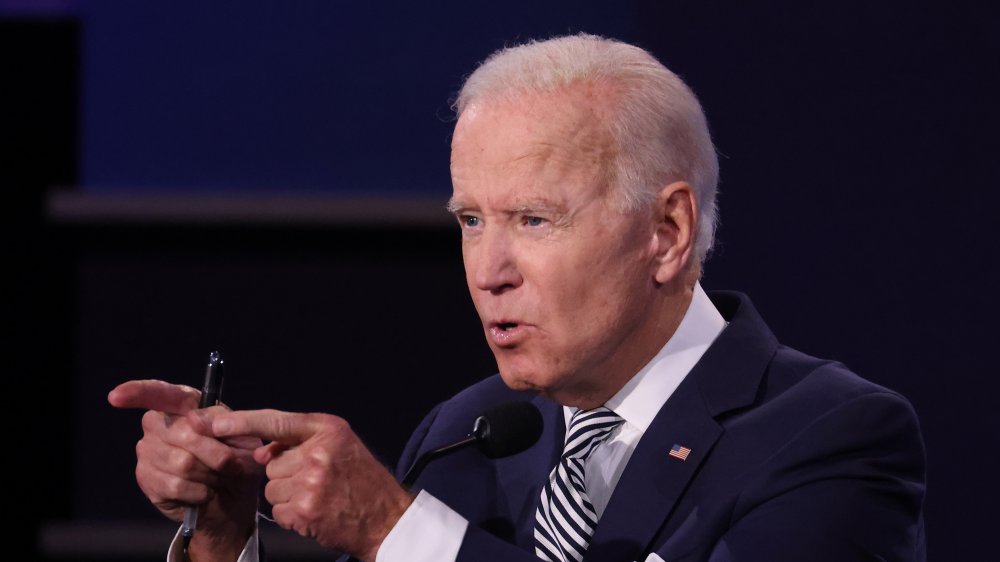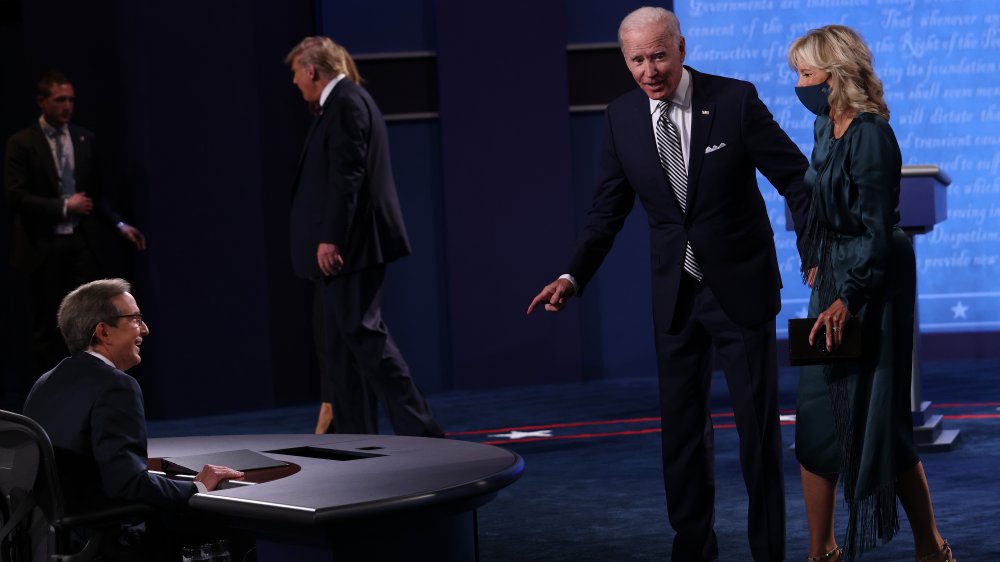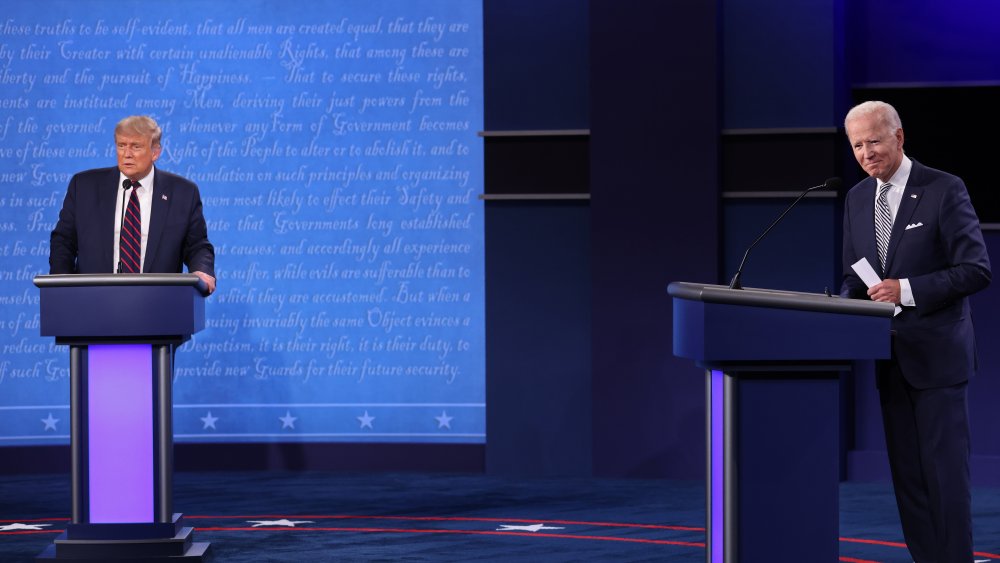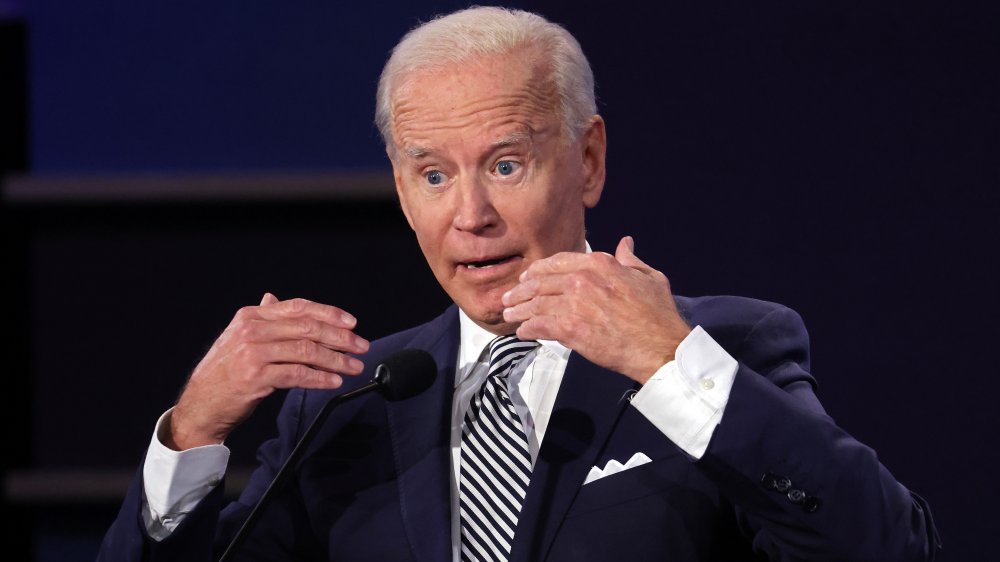Expert Reveals What Joe Biden's Body Language At The First Presidential Debate Really Means
So, what did it really feel like to be squaring off at the first 2020 presidential debate against Donald Trump? In last night's first of three official face-offs between President Donald Trump and former Vice President Biden, Trump repeatedly interrupted both his opponent and the moderator, Fox News' Chris Wallace, to the point where The Washington Post described his approach as "heckling" Biden's answers. Clearly, the evening wasn't bringing out the best in either man, with Trump repeating that Biden was "not smart," mocking his state education, and attacking Biden's son — and Biden calling the president a "clown," a "racist," and "the worst President America has ever had" (per CNN).
Biden's body language suggested that he was taken aback by Trump's personal insults, and he was frustrated that he couldn't get a word in edgewise, according to body language expert Dr. Reneé Carr, a psychologist and political and corporate advisor. "Biden does not appear comfortable arguing and seems to prefer organized, intellectual debates where each person's voice is heard and the conversation is both give-and-take," Carr explained. "Biden was clearly frustrated with Trump as evidenced by Biden's repeated chuckles of disbelief, wide-eyed stares of amazement, and explicit comments about Trump not adhering to the moderator's rules."
Biden was prepared for a traditional presidential debate
Biden had arrived at Case Western University in Cleveland, Ohio, prepared for the sort of carefully monitored debates he's participated in his decades of public service. According to Carr, you can tell this simply by looking the way he was dressed. "People choose their wardrobe colors and styles both consciously and unconsciously. Most often, a man's tie choice is more influenced by his subconscious beliefs about the event and desired impression he wants to make upon others," Carr explained. "Biden chose a black and white tie that was evenly striped. Such a choice reveals Biden's intent to provide debate responses based upon his long-held beliefs about what is either black or white — OR, in other words, wrong-or-right."
Even Biden's accessories suggested a certain old-fashioned formality, Carr added. "It is also interesting to note that he chose to wear a white pocket square, with white pocket squares usually reserved for formal occasions," she said. "This denotes that he approached the debate with President Trump as an event that was to be respected and with adhered-to formalities."
Biden's body language before the debate began portrayed strength; as Carr noted, "Biden approached the podium with his fists in front of his as if he were ready for a fight." Once it was his turn to speak, "Biden began the debate with responses focused on the end-value to voters and the possible impact of healthcare coverage loss."
Trump's interruptions eventually eroded at Biden's composure
According to Carr, Biden had an initial strategy for dealing with Trump's interruptions. "He deliberately ignored Trump by not making eye contact with him and maintaining a gaze with the moderator," she said. "This move appeared to be a strategic attempt to trigger an emotional reaction from President Trump and, therefore, cause Trump to have less focus on logic-based replies." At first, this seemed to pay off for Biden, Carr pointed out. "When Biden perceives that his tactic was effective, he finally turns to Trump and smiles as if he is being entertained," she said.
But this was when the entire event began to fly off the rails — and Biden's body language shows that he was not expecting Trump to get as aggressive as he did. "President Trump's response was more than what Biden expected, in that Biden soon began to look on in disbelief, his mouth open and his eyes staring at Trump," Carr said. At this point in the debate, "Trump began to disregard the debate protocols and repeatedly kept talking over the moderator."
Biden's emotions were all over his face, according to expert
While Biden stood relatively still without dramatic hand gestures as the debate began to unravel, his face revealed his emotions, Carr said. Some of this was strategic. "Biden maintained raised eyebrows to emphasize [concern about overturning] Roe v. Wade and healthcare loss to non-verbally emphasize his statements regarding the effect on voters when considering the timing of making a SCOTUS selection," Carr observed. "Biden's preferred approach was looking into the camera to make 'eye contact' with the viewing audience with the intent of making an emotional and direct connection with voters."
But, his face was also a dead giveaway when Trump pushed his buttons, Carr pointed out. "Biden became aggressive and frustrated when Trump began to speak negatively of Biden's sons," she noted. "To calm himself, Biden took a deep breath and closed his eyes in a display of extreme frustration with Trump's attempt to disgrace the memory of his deceased son as well as to speak ill of the challenges overcome by his remaining son."
Meanwhile, it was telling that Biden didn't really even look at Trump at all when he was speaking, Carr added. "Overall, Biden's primary body language was to attempt to ignore President Trump by Biden not making eye contact with him when it was his turn to speak; and looking at Trump only when Trump was speaking within moderator-approved times," she noted. "Biden also had his body angled away from Trump when speaking."



